List of optical illusions: Difference between revisions
Appearance
Content deleted Content added
Consolidated example columns |
No edit summary |
||
| Line 171: | Line 171: | ||
|[[Impossible object]] |
|[[Impossible object]] |
||
|[[File:Impossible cube illusion angle.svg|120px]] |
|[[File:Impossible cube illusion angle.svg|120px]] |
||
| |
|||
| |
|||
|-[[Impossible cube]] — The impossible cube was invented by [[M.C. Escher]] for ''[[Belvedere (M. C. Escher)|Belvedere]]'', a [[lithograph]] in which a boy seated at the foot of the building holds an impossible cube.<ref>{{cite book |author=Bruno Ernst (Hans de Rijk) |editor1-last=Schattschneider |editor1-first=D. |editor1-link=Doris Schattschneider |editor2-last=Emmer |editor2-first=M. |contribution=Selection is Distortion |pages=5–16 |publisher=Springer |title=M. C. Escher's Legacy: A Centennial Celebration |year=2003 |ref=harv |isbn=978-3-540-28849-7}}</ref><ref>{{Cite book |title=Impossibility: The Limits of Science and the Science of Limits |first=John D |last=Barrow |authorlink=John D. Barrow |publisher=Oxford University Press |year=1999 |isbn=9780195130829 |page=14 |url=http://books.google.com/books?id=0jRa1a4pD5IC&pg=PA14 |ref=harv}}</ref> |
|||
| |
|||
| |
|||
|-[[Penrose stairs]] — The Penrose stairs was created by [[Lionel Penrose]] and his son [[Roger Penrose]].<ref name=p1958/> A variation on the [[Penrose triangle]], it is a two-dimensional depiction of a staircase in which the stairs make four 90-degree turns as they ascend or descend yet form a continuous loop, so that a person could climb them forever and never get any higher. |
|||
| |
|||
| |
|||
|-[[Penrose triangle]]''' (Tribar) — The Penrose triangle was first created by the Swedish artist [[Oscar Reutersvärd]] in 1934. The [[mathematician]] [[Roger Penrose]] independently devised and popularised it in the 1950s, describing it as "impossibility in its purest form". |
|||
| |
|||
| |
|||
|-[[Blivet]] (or devil's tuning fork) — Blivet appears to have three cylindrical prongs at one end which then mysteriously transform into two rectangular prongs at the other end.<ref name=IFMW>{{Cite web |title=Impossible Fork |url=http://mathworld.wolfram.com/ImpossibleFork.html |publisher=[[Wolfram Research]] |accessdate=10 February 2014}}</ref> |
|||
| |
| |
||
|- |
|- |
||
Revision as of 10:10, 15 March 2014
This is a list of optical illusions.
| Name | Example | Notes | |
|---|---|---|---|
| Afterimage illusion | 
|
An afterimage or ghost image is an optical illusion that refers to an image continuing to appear in one's vision after the exposure to the original image has ceased. | |
| Afterimage on empty shape (also known as color dove illusion) | 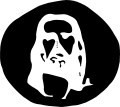
|
This type of illusions is designed to exploit graphical similarities. | |
| Ambiguous image | 
|
These are images that can form two separate pictures. For example the image shown forms a rabbit and a duck. | |
| Ames room illusion | 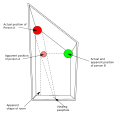
|
An Ames room is a distorted room that is used to create an optical illusion. | |
| Ames trapezoid window illusion | 
|
A window is formed in the shape of a trapezium. It is often hung and spun around to provide the illusion that the window rotates through less than 180 degrees. | |
| ASCII stereogram | An ASCII stereogram is an image that is formed using characters on a keyboard. | ||
| Autokinesis visual illusion | The autokinesis visual illusion is an illusion that forms due to the autokinetic effect. | ||
| Autokinetic effect | The autokinetic effect occurs when a stationary image appears to move. | ||
| Autostereogram |  
|
An autostereogram is a single-image stereogram (SIS), designed to create the visual illusion of a three-dimensional (3D) scene from a two-dimensional image in the human brain. | |
| Barberpole illusion | 
|
The barber pole illusion is a visual illusion that reveals biases in the processing of visual motion in the human brain. | |
| Benham's top | 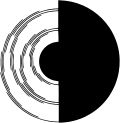
|
When a disk that has lines or colours on it is spun, it can form arcs of colour appear. | |
| Beta movement | Movement that appears to occur when fixed pictures turn on and off. | ||
| Bezold Effect | 
|
An apparent change of tone of a colour due to the alteration of the colour of the background. | |
| Blivet | 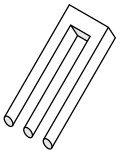
|
Also known as "poiuyt" or "devil's fork", this illusion is an impossible image because in reality the shape cannot exist. | |
| Café wall illusion | 
|
This illusion is a pattern where different coloured squares on a wall appear to form horizontal curved lines. It is named such because this is the type of artwork often seen on café walls. | |
| Catoptric cistula | 
|
A catoptric cistula is a box with insides made of mirrors so as to distort images of objects put into the box. | |
| Checker shadow illusion |  
|
The checker shadow illusions shows that when a shadow is cast onto a checked board, the colours of squares A and B in the photos appear to be different, when in fact they are the same. | |
| Chubb illusion | 
|
The Chubb illusion is an optical illusion or error in visual perception in which the apparent contrast of an object varies substantially to most viewers depending on its relative contrast to the field on which it is displayed. | |
| Color constancy | 
|
Colour constancy is an example of subjective constancy and a feature of the human color perception system which ensures that the perceived color of objects remains relatively constant under varying illumination conditions. A green apple for instance looks green to us at midday, when the main illumination is white sunlight, and also at sunset, when the main illumination is red. | |
| Color phi phenomenon | The color phi phenomenon is a perceptual illusion in which a disembodied perception of motion is produced by a succession of still images. | ||
| Contingent perceptual aftereffect | |||
| Convergence micropsia | |||
| Cornsweet illusion | 
|
An illusion where two colours can obviously be seen to be different when placed directly beside each other; however, when the two colours are separated by a thick black line, they appear to be of the same hue. | |
| Delboeuf illusion | |||
| Disappearing Model | |||
| Ebbinghaus illusion | 
|
||
| Ehrenstein illusion |  
|
The Ehrenstein illusion is an optical illusion studied by the German psychologist Walter Ehrenstein in which the sides of a square placed inside a pattern of concentric circles take an apparent curved shape. | |
| Fechner color | |||
| Figure-ground (perception) | 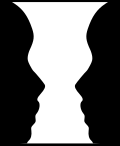
|
||
| Filling-in | 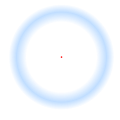
|
||
| Flash lag illusion | |||
| Forced perspective | |||
| Fraser spiral illusion | 
|
||
| Gravity hill | |||
| Grid illusion | 
|
||
| Hering illusion | 
|
||
| Hollow-Face illusion | 
|
The Hollow-Face illusion is an optical illusion in which the perception of a concave mask of a face appears as a normal convex face. | |
| Hybrid image | 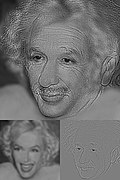
|
A Hybrid Image is an optical illusion developed at MIT in which an image can be interpreted in one of two different ways depending on viewing distance. | |
| Illusory contours | 
|
Illusory contours or subjective contours are a form of visual illusion where contours are perceived without a luminance or color change across the contour. | |
| Illusory motion | |||
| Impossible object | 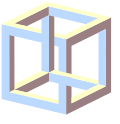
|
||
| Irradiation illusion | |||
| Isometric illusion | 
|
An isometric illusion (also called an ambiguous figure or inside/outside illusion) is a type of optical illusion, specifically one due to multistable perception. | |
| Jastrow illusion | 
|
The Jastrow illusion is an optical illusion discovered by the American psychologist Joseph Jastrow in 1889. | |
| Kanizsa triangle | 
|
The Kanizsa triangle is an optical illusion first described by the Italian psychologist Gaetano Kanizsa in 1955. It is a triangle formed of illusory contours. | |
| Leaning tower illusion | The Leaning Tower Illusion is an optical illusion that presents two identical images of the Leaning Tower of Pisa side by side. | ||
| Lilac chaser | 
|
Lilac chaser is a visual illusion, also known as the Pac-Man illusion. | |
| Liquid crystal shutter glasses | |||
| Mach bands | 
|
Mach bands is an optical illusion named after the physicist Ernst Mach. | |
| Magic Eye | |||
| McCollough effect | 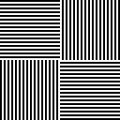
|
||
| Missing square puzzle | 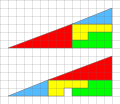 
|
The missing square puzzle is an optical illusion used in mathematics classes to help students reason about geometrical figures. | |
| Moon illusion | 
|
The Moon illusion is an optical illusion in which the Moon appears larger near the horizon than it does while higher up in the sky. | |
| Motion aftereffect | |||
| Motion illusion | 
|
||
| Müller-Lyer illusion | 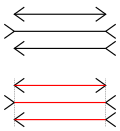
|
The Müller-Lyer illusion is an optical illusion consisting of a stylized arrow. | |
| Multistability | |||
| Musion Eyeliner | |||
| Necker cube illusion | The Necker Cube is an optical illusion first published in 1832 by Swiss crystallographer Louis Albert Necker. | ||
| Necker Cube | 
|
||
| Numerosity adaptation effect | 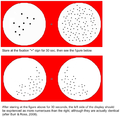
|
||
| Orbison illusion | 
|
The Orbison illusion is an optical illusion that was first described by the psychologist William Orbison in 1939. | |
| Penrose stairs | 
|
||
| Penrose triangle | 
|
||
| Pepper's ghost | |||
| Perceived visual angle | 
|
||
| Peripheral drift illusion | 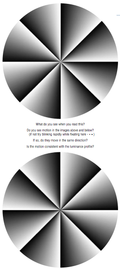
|
||
| Phantogram | 
|
Phantograms, also known as Phantaglyphs, Op-Ups, free-standing anaglyphs, levitated images, and book anaglyphs, are a form of optical illusion. | |
| Phi phenomenon | |||
| Poggendorff illusion | 
|
||
| Poiuyt | |||
| Ponzo illusion | 
|
||
| Rubin vase | File:Rubin2.jpg | ||
| Sander illusion | |||
| Silencing | 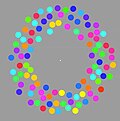
|
Silencing is an illusion in which a set of objects that change in luminance, hue, size, or shape appears to stop changing when it moves. | |
| Size–weight illusion | The size–weight illusion is also known as the Charpentier illusion (or Charpentier–Koseleff illusion). | ||
| Stroboscopic effect | |||
| Swept-plane display | |||
| Ternus illusion | |||
| Thaumatrope | 
|
A thaumatrope is a toy that was popular in Victorian times. | |
| The Spinning Dancer | 
|
||
| Trompe-l'œil | |||
| Troxler's fading | |||
| Vertical–horizontal illusion | 
|
||
| Visual tilt effects |  
| ||
| Wagon-wheel effect | 
|
||
| White's illusion | 
|
||
| Wundt illusion | 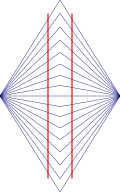
|
||
| Zoetrope | 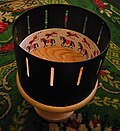
|
||
| Zöllner illusion | 
|
The Zöllner illusion is a classic optical illusion named after its discoverer, German astrophysicist Johann Karl Friedrich Zöllner. |
See also
- Adaptation (eye)
- Alice in Wonderland syndrome
- Auditory illusion
- Barber's pole
- Camouflage
- Contingent perceptual aftereffect
- Contour rivalry
- Depth perception
- Emmert's law
- Entoptic phenomenon
- Forced perspective – application used in film and architecture to create the illusion of larger, more distant objects.
- Gestalt psychology
- Gravity hill
- Infinity pool
- Kinetic depth effect
- Mirage
- Multistable perception
- Op Art
- Trompe l'oeil
- Visual reorientation illusions
Notes
- ^ Bruno Ernst (Hans de Rijk) (2003). "Selection is Distortion". In Schattschneider, D.; Emmer, M. (eds.). M. C. Escher's Legacy: A Centennial Celebration. Springer. pp. 5–16. ISBN 978-3-540-28849-7.
{{cite book}}: Invalid|ref=harv(help) - ^ Barrow, John D (1999). Impossibility: The Limits of Science and the Science of Limits. Oxford University Press. p. 14. ISBN 9780195130829.
{{cite book}}: Invalid|ref=harv(help) - ^ Cite error: The named reference
p1958was invoked but never defined (see the help page). - ^ "Impossible Fork". Wolfram Research. Retrieved 10 February 2014.
External links
Wikimedia Commons has media related to Optical illusion.
- Optical Illusions & Visual Phenomena by Michael Bach
- Optical Illusions Database by Mighty Optical Illusions
- Optical illusions and perception paradoxes by Archimedes Lab
- http://ilusaodeotica.com hundreds of optical illusions
- Project LITE Atlas of Visual Phenomena
- Akiyoshi's illusion pages Professor Akiyoshi KITAOKA's anomalous motion illusions
- Spiral Or Not? by Enrique Zeleny, Wolfram Demonstrations Project
- Magical Optical Illusions by Rangki
- Hunch Optical Illusions by Hunch
